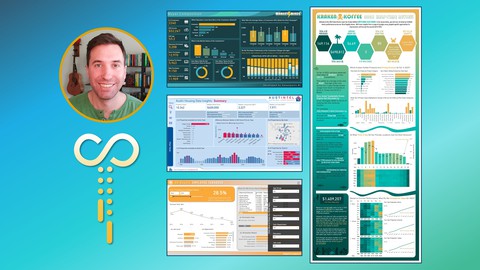Data Warehouse Fundamentals for Beginners
Loại khoá học: Business Analytics & Intelligence
Best Practices and Concepts for Architecture and Dimensional Design
Mô tả
If you are a current or aspiring IT professional in search of sound, practical techniques to plan, design, and build a data warehouse or data mart, this is the course for you.
During the course, you’ll put what you learn to work and define sample data warehousing architectures and dimensional data structures to help emphasize the best practices and techniques covered in this course. Each section has either scenario based quiz questions or hands on assignments that emphasizes key learning objectives for that section’s material. This way, you can be confident as you move through the course that you’re picking up the key points about data warehousing.
To build this course, I drew from more than 30 years of my own data warehousing work on more than 40 client projects and engagements. I’ve been a thought leader in the discipline of data warehousing since the early 1990s when modern data warehousing came onto the scene. I’ve literally seen it all...and written about the discipline of data warehousing in books such as the original Data Warehousing For Dummies ® , along with articles, white papers, and as a monthly data warehousing columnist. I’ve led global consulting practices delivering data warehousing (and its related discipline, business intelligence) to some of the most recognizable brand name customers, along with smaller-sized organizations and governmental agencies. My own consulting firm, Thinking Helmet, Inc., specializes in data warehousing, business intelligence, and related disciplines. I’ve rolled up my sleeves and personally tackled every aspect of what you’ll learn in this course. I’ve even learned a few painful lessons, and have built a healthy share of “lessons learned” into the course material.
In this course, I take you from the fundamentals and concepts of data warehousing all the way through best practices for the architecture, dimensional design, and data interchange that you’ll need to implement data warehousing in your organization. You’ll find many examples that clearly demonstrate the key concepts and techniques covered throughout the course. By the end of the course, you’ll be all set to not only put these principles to work, but also to make the key architecture and design decisions required by the “art” of data warehousing that transcend the nuts-and-bolts techniques and design patterns.
Specifically, this course will cover:
Foundational data warehousing concepts and fundamentals
The symbiotic relationship between data warehousing and business intelligence
How data warehousing co-exists with data lakes and data virtualization
Your many architectural alternatives, from highly centralized approaches to numerous multi-component alternatives
The fundamentals of dimensional analysis and modeling
The key relational database capabilities that you will put to work to build your dimensional data models
Different alternatives for handling changing data history within your environment, and how to decide which approaches to apply in various situations
How to organize and design your Extraction, Transformation, and Loading (ETL) capabilities to keep your data warehouse up to date
Data warehousing is both an art and a science. While we have developed a large body of best practices over the years, we still have to make this-or-that types of decisions from the earliest stages of a data warehousing project all the way through architecture, design, and implementation. That’s what I’ve instilled into this course: the fusion of data warehousing art and science that you can bring to your organization and your own work. So come join me on this journey through the world of data warehousing!
Bạn sẽ học được gì
Master the techniques needed to build a data warehouse for your organization.
Determine your options for the architecture of your data warehousing environment.
Apply the key design principles of dimensional data modeling.
Combine various models and approaches to unify and load data within your data warehouse.
Yêu cầu
- A basic understanding of (but not necessarily programming experience with) relational databases and SQL fundamentals, specifically how you use the SQL CREATE TABLE statement to create data structures in a relational database.
Nội dung khoá học
Viết Bình Luận
Khoá học liên quan

Đăng ký get khoá học Udemy - Unica - Gitiho giá chỉ 50k!
Get khoá học giá rẻ ngay trước khi bị fix.


















Đánh giá của học viên
Bình luận khách hàng